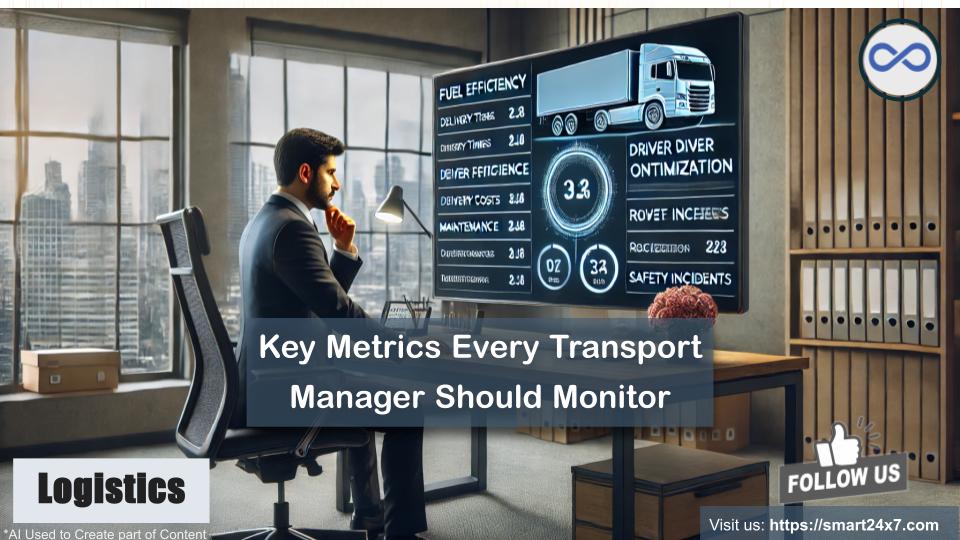Effective transportation management relies on a deep understanding of key performance metrics that drive efficiency, safety, and customer satisfaction. At Smart24x7, the best employee transport management platform, we empower transport heads and procurement managers with the tools they need to monitor and optimize their operations. Here are the key metrics every transport manager responsibility should focus on to ensure smooth and effective fleet management.
- Fleet Utilization Rate
Maximizing Resource Efficiency:- Vehicle Utilization: Measure the percentage of time vehicles are in use compared to their availability. High utilization indicates efficient resource use.
- Capacity Utilization: Track how well the available capacity (e.g., number of seats) is being used. Aim to maximize capacity usage without overloading.
Benefits: - Reduces idle time and increases the return on investment (ROI) for each vehicle.
- Helps in planning fleet management size and composition.
- Fuel Consumption and Efficiency
Monitoring and Reducing Fuel Costs:- Fuel Consumption per Mile/Kilometer: Track the amount of fuel consumed relative to the distance traveled.
- Fuel Efficiency Trends: Analyze fuel consumption over time to identify trends and areas for improvement.
Benefits: - Identifies vehicles or driving habits that cause excessive fuel consumption.
- Helps implement fuel-saving strategies, reducing overall operational costs.
- Maintenance and Repair Costs
Ensuring Vehicle Reliability:- Total Maintenance Costs: Monitor the overall costs of maintaining and repairing vehicles.
- Cost per Vehicle: Break down maintenance costs for individual vehicles to identify those that are costlier to maintain.
Benefits: - Helps in budgeting for maintenance and identifying vehicles that may need replacement.
- Ensures vehicles are in optimal condition, reducing breakdowns and enhancing safety.
- Driver Performance and Behavior
Enhancing Safety and Efficiency:- Driving Hours: Track the hours drivers spend on the road to ensure compliance with regulations and prevent fatigue.
- Driving Behavior: Monitor behaviors such as speeding, harsh braking, and rapid acceleration.
Benefits: - Improves safety by encouraging good driving practices.
- Reduces the risk of accidents and associated costs.
- On-Time Delivery and Pickup Rates
Meeting Customer Expectations:- On-Time Delivery Rate: Measure the percentage of deliveries made on time.
- On-Time Pickup Rate: Track the punctuality of pickups, ensuring adherence to schedules.
Benefits: - Enhances customer satisfaction and trust in the service.
- Helps identify and address issues causing delays.
- Route Efficiency
Optimizing Travel Routes:- Average Route Time: Track the time taken to complete routes and identify variations.
- Route Deviation Rates: Monitor how often and why deviations from planned routes occur.
Benefits: - Reduces fuel consumption and travel time.
- Helps in planning more efficient routes, saving costs and time.
- Customer Feedback and Satisfaction
Improving Service Quality:- Customer Satisfaction Scores: Collect and analyze feedback from customers to gauge their satisfaction levels.
- Complaint Rates: Track the number and types of complaints to identify areas needing improvement.
Benefits: - Directs attention to service areas that need enhancement.
- Builds a loyal customer base by addressing and resolving issues promptly.
- Cost per Mile/Kilometer
Managing Operational Costs:- Total Operational Costs: Calculate the total costs involved in running the fleet, including fuel, maintenance, and labor.
- Cost per Mile/Kilometer: Break down these costs by distance traveled to understand cost efficiency.
Benefits: - Identifies cost-saving opportunities.
- Provides a clear picture of operational efficiency.
- Compliance and Safety Metrics
Ensuring Regulatory Adherence:- Compliance Rates: Monitor adherence to regulatory requirements such as driver hours, vehicle maintenance, and safety standards.
- Safety Incidents: Track the number and types of safety incidents to improve safety protocols.
Benefits: - Minimizes the risk of fines and legal issues.
- Enhances the overall safety of the fleet and its operations.
- Utilization of Technology
Leveraging Technological Advancements:- Technology Adoption Rate: Measure how effectively the latest technologies are being utilized within the fleet.
- Impact of Technology on Operations: Assess the improvements in efficiency and cost savings due to technology adoption.
Benefits: - Keeps the fleet management system up-to-date with the latest advancements.
- Drives continuous improvement and innovation.
Monitoring these key metrics provides transport managers responsibilities with invaluable insights into their operations, helping them make informed decisions that enhance efficiency, safety, and customer satisfaction. At Smart24x7, we offer comprehensive solutions to help you track and optimize these metrics, ensuring your fleet operates at peak performance.
Smart24x7 is proud to be part of the Incubation program run by Smart Group India, continually striving to innovate and lead in the employee transport management sector. Embrace the power of data and technology with Smart24x7 to drive your fleet operations to new heights.
